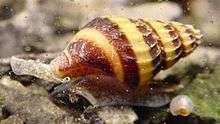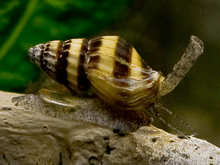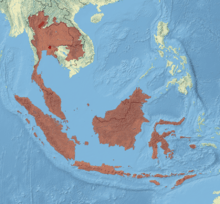Anentome helena
Anentome helena, common name assassin snail or bumblebee snail, is a species of freshwater snail with an operculum, an aquatic gastropod in the family Nassariidae, most of which are marine.[2]
| Anentome helena | |
|---|---|
 | |
 | |
| Scientific classification | |
| Kingdom: | Animalia |
| Phylum: | Mollusca |
| Class: | Gastropoda |
| Clade: | Caenogastropoda |
| Clade: | Hypsogastropoda |
| Clade: | Neogastropoda |
| Family: | Nassariidae |
| Genus: | Anentome |
| Species: | A. helena |
| Binomial name | |
| Anentome helena (von dem Busch, 1847) | |
 | |
| Distribution map of Anentome helena | |
| Synonyms[1] | |
| |
Distribution
This species occurs throughout southeast Asia, especially in Malaysia, Thailand, and in Lake Toba on the Indonesian island Sumatra.[3][4]
Description
This snail will typically grow to 0.7–1.25 in (20–35 mm) in size depending on food sources, usually smaller in the aquarium. The shell, which is conical in shape, often consists of dark brown and yellowish tan bands, leading to some people to refer to this snail as the bumble bee snail, a name also applied to the marine snail Engina mendicaria. Some specimens have been identified with completely brown shells, lacking banding.
Ecology
Habitat
The snails will spend much of their time buried in their substrate. They are least active during mid day, however they can sense food and will become active if fed.[5]
Feeding habits
Like all snails in the clade Neogastropoda, this species is carnivorous. It feeds on worms and gastropods, and is often known as the "assassin snail" for its habit of eating other snails. These snails will often feed on larger snails, often burying themselves and ambushing their prey.[2]
Anentome helena may be a serious threat to native freshwater gastropods in countries, when introduced.[6]
Life cycle
Anentome helena consists of defined male and female individuals which are not hermaphroditic. Currently it is not known how to identify which is male and which is female. Both males and females seem to be the same size and shape. When a male and female mate, they lock together for many hours. The female lays several clear egg capsules which are square in shape and approximately 1.0 to 1.5 mm in width and height. Each egg capsule contains a single small yellow egg. The egg capsules are generally laid on solid surfaces such as plastic and often on the base of plants. Fertile eggs usually hatch within a few weeks.[5]
Human use
It is a part of ornamental pet trade for freshwater aquaria.[7]
References
- Bouchet, P. (2017). Anentome helena (von dem Busch, 1847). In: MolluscaBase (2017). Accessed through: World Register of Marine Species at http://www.marinespecies.org/aphia.php?p=taxdetails&id=1027029 on 2017-11-21
- Monks, Neale (2009). "Assassin Snails and Sulawesi Elephant Snails: Keeping Clea and Tylomelania in the aquarium". Conscientious Aquarist Magazine. Retrieved March 11, 2014.
- "Map of Clea helena". Discover Life. National Biological Information Infrastructure. Retrieved March 8, 2014.
- (in Thai) Boon-ngam P., Sriyarun J., Tanamai S. & Dumrongrojwattana P. (PDF file created 12 January 2010). "การศึกษาเบืองต้ นความหลากชนิดของหอยทากบก และหอยนําจืดในจังหวัดสระแก้ ว Preliminary taxonomic study of land snail and freshwater mollusk species in Sakaeo Province, Eastern Thailand". 10 pp., pages unnumbered. PDF.
- Newel, M. S.; Bourne, G. B. (January 5, 2013). "The 'assassin' snail, Clea (Anentome) helena (Gastropoda: Buccinidae), as a model for developmental and environmental physiology" (PDF). Society for Integrative and Comparative Developmental Biology 2013 Annual Meeting.
- Mienis, H. K. (2011). "Will the Uncontrolled Sale of the Snail-eating Gastropod Anentome helena in Aquarium Shops in Israel Result in Another Disaster for Israel's Native Freshwater Mollusc Fauna?" (PDF). Ellipsaria: 10–11.
- Ng, T. H., Tan, S. K., Wong, W. H., Meier, R., Chan, S. Y., Tan, H. H., & Yeo, D. C. (2016). "Molluscs for sale: assessment of freshwater gastropods and bivalves in the ornamental pet trade". PLoS ONE 11(8): e0161130. doi:10.1371/journal.pone.0161130
External links
| Wikimedia Commons has media related to Anentome helena. |